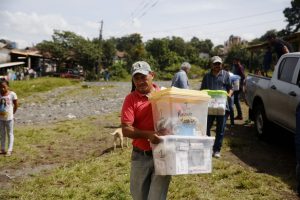
Morelia, Guatemala, Jul 24 (EFE).- “If that fills up we’ll have no way to leave,” Delfino said, pointing at a ravine some 100 meters (327 feet) deep with a small river flowing along it. He was imagining the 10,000 people who live near Guatemala’s Fire volcano being condemned to death, lost and forgotten.
It was a little past 10 am and the sun was scorching. People were meeting at the health center. A group of volunteer doctors and nurses had arrived for a day of providing free medical care. Almost no drinking water was available there and the diseases were mounting.
At times the noise and talk took over: children were running around while a group of men spoke about the June 3 volcano eruption that took the lives of 138 people and left more than 280 missing.
Delfino, who has lived his whole life in Morelia beside the volcano, told what it was like.
“The people were frightened. What they saw wasn’t easy and they were terrified,” he said. The pain and anguish still haunted his grey eyes. “It looked like everything was going to fall on us, but then it didn’t,” he said. It was destiny that saved Morelia from disaster.
But the danger in Morelia, like that in Panimache I and II, El Porvenir, Cocales and Sangre de Cristo is constant. In a maroon van that roared like a maddened wild bull, Delfino drove up the narrow, impassable streets full of potholes in order to show his passengers where the threat lay.
He stopped at a checkpoint: “Edgar, how’s it going? They want to see the ravine.” “Let’s go,” he replied.
Trudging across several farms they came to the precipice, from where they saw a small river below, Taniluya. “The material deposited by the volcano is 1.5 km (1 mile) away. Over there,” indicated Edgar Leonel Misa, president of the Community Council of Panimache I.
Now all that landslide of volcanic debris known as lahar could pour down with the rain into the ravine and leave them totally stranded. The only way to reach those villages was a steep road that goes over the Pantaleon River, into which the Taniluya flows. But there was no bridge. One would have to bumble from stone to stone over the water.
“When it rains it fills up. It sweeps everything away with it. It comes at an incredible speed and carries little boats into the trees,” Edgar said. If that happens, “we’ll have no way to leave,” he said.
“All we ask is bridges. Four bridges and a road in good condition,” he said.
